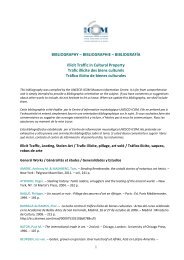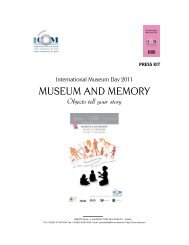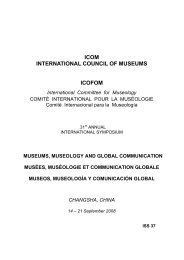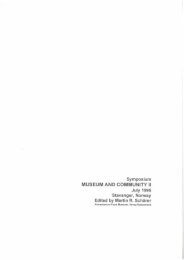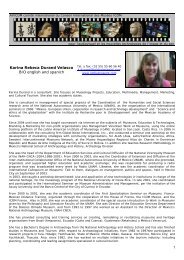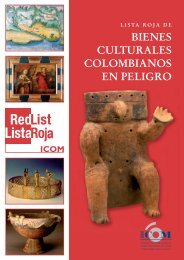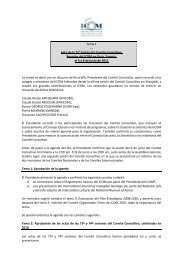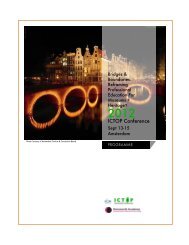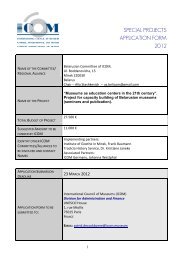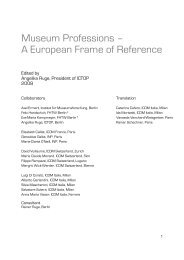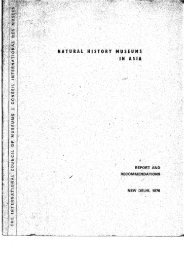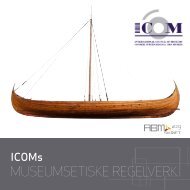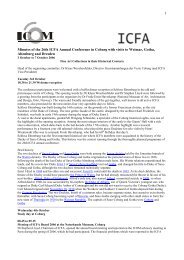Key Concepts of Museology - ICOM
Key Concepts of Museology - ICOM
Key Concepts of Museology - ICOM
Create successful ePaper yourself
Turn your PDF publications into a flip-book with our unique Google optimized e-Paper software.
62<br />
In this sense the object is abstract<br />
and dead, closed on itself, as evidenced<br />
by that series <strong>of</strong> objects which<br />
is a collection (Baudrillard, 1968).<br />
This status <strong>of</strong> the object is considered<br />
today to be a purely western product<br />
(Choay, 1968; Van Lier, 1969;<br />
Adotevi, 1971), in so far as it was the<br />
West which broke with the tribal<br />
way <strong>of</strong> life and thought about the gap<br />
between subjects and objects for the<br />
fi rst time (Descartes, Kant, and later<br />
McLuhan, 1969).<br />
2. Through their work <strong>of</strong> acquisition,<br />
research, preservation and<br />
communication, museums can be<br />
presented as one <strong>of</strong> the major authorities<br />
in the ‘production’ <strong>of</strong> objects.<br />
In this case, the museum object –<br />
musealium or musealia – does not<br />
have any intrinsic reality, even if the<br />
museum is not the only instrument<br />
to ‘produce’ objects. In fact other<br />
approaches are ‘objectivising’ as is<br />
the case in particular for scientifi<br />
c processes to establish reference<br />
standards (c.f., measurement scales)<br />
which are completely independent <strong>of</strong><br />
the subject and which consequently<br />
fi nd it diffi cult to treat that which is<br />
living as such (Bergson) because it<br />
tends to turn it into an object, wherein<br />
lies the diffi culty <strong>of</strong> physiology<br />
compared to anatomy. The museal<br />
object is made to be seen, with its<br />
whole mass <strong>of</strong> implicit connotations,<br />
because we can display it in order<br />
to stir emotions, to entertain, or to<br />
teach. This action <strong>of</strong> displaying is so<br />
essential that it is what turns a thing<br />
into an object by creating this dis-<br />
tance, whereas the priority in scientifi<br />
c operations is the requirement<br />
to account for things in a universally<br />
intelligible context.<br />
3. Naturalists and ethnologists,<br />
as well as museologists, generally<br />
select things which they already call<br />
objects, according to their potential<br />
as evidence, that is the quality<br />
<strong>of</strong> information (markers) that they<br />
can provide to refl ect the ecosystems<br />
or cultures the traces <strong>of</strong> which<br />
they wish to preserve. “Musealia<br />
(museum objects) are authentic<br />
movable objects which, as irrefutable<br />
evidence, show the development <strong>of</strong><br />
nature and society” (Schreiner 1985).<br />
The wealth <strong>of</strong> information they<br />
provide has led ethnologists such<br />
as Jean Gabus (1965) or Georges<br />
Henri Rivière (1989) to attribute to<br />
them the name witness-object, which<br />
they retain when they are displayed.<br />
Georges Henri Rivière even used the<br />
expression symbol-object to describe<br />
certain witness objects heavy with<br />
content which might claim to summarise<br />
a whole culture or period.<br />
The result <strong>of</strong> systematically making<br />
things into objects is that they can<br />
be studied much better than if they<br />
were still in their original context<br />
(ethnographic fi eld, private collection<br />
or gallery), but it can also become<br />
fetishist: a ritual mask, a ceremonial<br />
costume, a prayer tool etc. quickly<br />
change their status when they enter<br />
the museum. We are no longer in<br />
the real world, but in the imaginary<br />
world <strong>of</strong> the museum. For example,<br />
the visitor is not allowed to sit on



